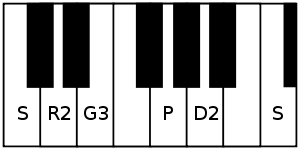- Mohanam
-
Carnatic Music Concepts Sruti • Swara • Raga • Tala • Melakarta • Asampurna Melakarta
Compositions Varnam • Kriti • Geetham • Swarajati • Ragam Thanam Pallavi • Thillana
Instruments melody: Vocals • Saraswati veena • Venu • Violin • Chitra veena • Nadaswaram • Mandolin
rhythm: Mridangam • Ghatam • Morsing • Kanjira • Thavil
drone: Tambura • Shruti box
Composers Mohanam (pronounced Mōhanam, Sanskrit: मोहनम,Telugu: మోహన, Tamil: மோகனம்) is a rāgam in Carnatic music (musical scale of South Indian classical music). It is an audava rāgam (or owdava rāgam, meaning pentatonic scale). It is a janya rāgam (derived scale), as it does not have all the seven swaras (musical notes).
The equivalent of Mohanam in Hindustani music is Bhoop[1] (or Bhopali[2]).
It is one of the common pentatonic scales across the world[1] and is very popular in East Asian and South-east Asian music, including China and Japan.
Contents
Structure and Lakshana
Mohanam is a symmetric rāgam that does not contain madhyamam or nishādham. It is a symmetric pentatonic scale (audava-audava ragam[1][2] in Carnatic music classification - audava meaning 'of 5'). Its ārohaṇa-avarohaṇa structure (ascending and descending scale) is as follows (see swaras in Carnatic music for details on below notation and terms):
(the notes used in this scale are shadjam, chathusruthi rishabham, antara gandharam, panchamam, chathusruthi dhaivatham)
Mohanam is considered a janya rāgam of Harikambhoji, the 28th Melakarta rāgam, though it can be derived from other melakarta rāgams, Kalyani, Sankarabharanam or Vachaspati, by dropping both madhyamam and nishādham. The hindustani equivalent Bhoop is associated with Kalyan thaat (equivalent of Kalyani).
Popular compositions
Mohanam rāgam lends itself for extensive elaboration and exploration and has many compositions in both classical music and film music. The geetham Varavina mrithupani is one of the first short songs taught to beginners in Carnatic music. Ninnukori composed by Poochi Srinivasa Iyengar is a popular Varnam in this scale. Here are some popular kritis composed in Mohanam.
- Mohana rama, Nannu palimpa,Darayani, Rama ninnu nammina, Evarura ninnuvina and Bhavanutha by Thyagaraja
- Narasimha Agache by Muthuswamy Dikshitar
- Kapaali, karunai and Narayana divyanamam by Papanasam Sivan
- Rara Rajeevalochana by Mysore Vasudevachar
- En palli kondeer by Arunachala Kavi
- Sada palaya by G. N. Balasubramaniam
- Kshemam kuru by Narayana Teertha
Related rāgams
This section covers the theoretical and scientific aspect of this rāgam.
Graha bedham
Mohanam's notes when shifted using Graha bedham, yields 4 other major pentatonic rāgams, namely, Hindolam, Shuddha Saveri, Udayaravichandrika (also known as Shuddha Dhanyasi) and Madhyamavati. Graha bedham is the step taken in keeping the relative note frequencies same, while shifting the shadjam to the next note in the rāgam. For more details and illustration of this concept refer Graha bedham on Mohanam.
Scale similarities
- Mohanakalyani is a rāgam which has the ascending scale of Mohanam and descending scale of Kalyani. Its ārohaṇa-avarohaṇa structure is S R2 G3 P D2 S : S N3 D2 P M2 G3 R2 S
- Bilahari is a rāgam which has the ascending scale of Mohanam and descending scale of Sankarabharanam. Its ārohaṇa-avarohaṇa structure is S R2 G3 P D2 S : S N3 D2 P M1 G3 R2 S
- Garudadhvani is a rāgam which has the ascending scale of Sankarabharanam and descending scale of Mohanam. Its ārohaṇa-avarohaṇa structure is S R2 G3 M1 P D2 N3 S : S D2 P G3 R2 S
- Shivaranjani rāgam differs from Mohanam only by the gāndhāram. It uses sadharana gāndhāram instead of antara gāndhāram and its ārohaṇa-avarohaṇa structure is S R2 G2 P D2 S : S D2 P G2 R2 S
- Hamsadhvani rāgam uses nishadam in place of dhaivatam. Its ārohaṇa-avarohaṇa structure is S R2 G3 P N3 S : S N3 P G3 R2 S
- Vaasanthi rāgam differs from Mohanam only by the daivatham. It uses shudda daivatham instead of chatushruti daivatham and its ārohaṇa-avarohaṇa structure is S R2 G3 P D1 S : S D1 P G3 R2 S
- Niroshta rāgam uses nishadam in place of panchamam. Its ārohaṇa-avarohaṇa structure is S R2 G3 D2 N3 S : S N3 D2 G3 R2 S
References
- ^ a b c Ragas in Carnatic music by Dr. S. Bhagyalekshmy, Pub. 1990, CBH Publications
- ^ a b Raganidhi by P. Subba Rao, Pub. 1964, The Music Academy of Madras
Melakarta Ragas Shuddha
Madhyama
RagasIndu chakraNetra chakraAgni chakra13. Gayakapriya · 14. Vakulabharanam · 15. Mayamalavagowla · 16. Chakravakam · 17. Suryakantam · 18. HatakambariVeda chakra19. Jhankaradhvani · 20. Natabhairavi · 21. Keeravani · 22. Kharaharapriya · 23. Gourimanohari · 24. VarunapriyaBana chakra25. Mararanjani · 26. Charukesi · 27. Sarasangi · 28. Harikambhoji · 29. Dheerasankarabharanam · 30. NaganandiniRitu chakra31. Yagapriya · 32. Ragavardhini · 33. Gangeyabhushani · 34. Vagadheeswari · 35. Shulini · 36. ChalanataPrati
Madhyama
RagasRishi chakraVasu chakra43. Gavambhodi · 44. Bhavapriya · 45. Shubhapantuvarali · 46. Shadvidamargini · 47. Suvarnangi · 48. DivyamaniBrahma chakra49. Dhavalambari · 50. Namanarayani · 51. Kamavardani · 52. Ramapriya · 53. Gamanashrama · 54. VishwambariDisi chakra55. Shamalangi · 56. Shanmukhapriya · 57. Simhendramadhyamam · 58. Hemavati · 59. Dharmavati · 60. NeetimatiRudra chakra61. Kantamani · 62. Rishabhapriya · 63. Latangi · 64. Vachaspati · 65. Mechakalyani · 66. ChitrambariAditya chakra67. Sucharitra · 68. Jyoti swarupini · 69. Dhatuvardani · 70. Nasikabhushani · 71. Kosalam · 72. RasikapriyaCarnatic music · Swaras · Ragas · Asampurna Melakarta Ragas Janya Ragas A-D Abheri · Abhogi · Andolika · Amritavarshini · Anandabhairavi · Arabhi · Atana · Bhairavi · Bhupalam · Bilahari · Devagandhari · DhanyasiG-K M-N Madhuvanti · Madhyamavati · Malahari · Malayamarutam · Mohanakalyani · Mohanam · Nagasvaravali · NiroshtaR-S Ranjani · Revati · Sahana · Saramati · Saveri · Shivaranjani · Shuddha Saveri · Shree ranjani · SunadavinodiniU-V Udayaravichandrika (Shuddha Dhanyasi) · ValajiCarnatic music · Melakarta Ragas · Asampurna Melakarta Ragas · List of Janya Ragas Categories:- Carnatic Ragas
Wikimedia Foundation. 2010.

